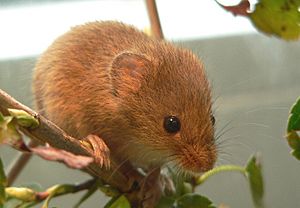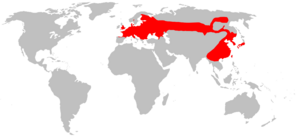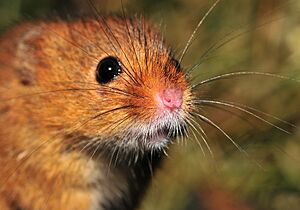Eurasian harvest mouse facts for kids
Quick facts for kids Eurasian harvest mouse |
|
|---|---|
 |
|
| Conservation status | |
| Scientific classification | |
| Genus: |
Micromys
|
| Species: |
minutus
|
 |
|
| Distribution of Eurasian harvest mouse | |
The harvest mouse (Micromys minutus) is a tiny rodent that lives in Europe and Asia. You can often find these mice in fields of cereal crops like wheat and oats. They also live in reed beds, long grass, and hedgerows.
Harvest mice have reddish-brown fur on their backs and white fur underneath. They have a special tail that can grip things, called a prehensile tail. They use this tail to help them climb. It is the smallest rodent in Europe. An adult harvest mouse can weigh as little as 4 grams (0.14 oz), which is super light! They mostly eat seeds and insects, but also enjoy nectar and fruit. Their nests are round, made from woven grass, and attached to plant stems high above the ground.
Contents
The History of Harvest Mice
The group of mice called Micromys likely first appeared in Asia. They are related to other climbing mice. The first signs of Micromys in fossils are from a time called the late Pliocene period. Micromys minutus fossils have been found in Germany from the early Pleistocene period.
During very cold periods, called glacial periods, harvest mice lived in areas of Europe that were not covered in ice. Later, during the mid-Pleistocene, they also lived in parts of Asia. This suggests they spread to Asia when the ice started to melt. Some experts think harvest mice might have come to new places by accident during Neolithic times, carried along with farm crops.
Before the harvest mouse was officially named, a man named Gilbert White wrote about their nests in Selborne, Hampshire:
They never enter into houses; are carried into ricks and barns with the sheaves; abound in harvest; and build their nests amidst the straws of the corn above the ground, and sometimes in thistles. They breed as many as eight at a litter, in a little round nest composed of the blades of grass or wheat. One of these nests I procured this autumn, most artificially platted, and composed of the blades of wheat; perfectly round, and about the size of a cricket-ball. It was so compact and well-filled, that it would roll across the table without being discomposed, though it contained eight little mice that were naked and blind.
Today, even tennis balls used at Wimbledon are recycled to make special artificial nests for harvest mice!
What Does a Harvest Mouse Look Like?
A harvest mouse is usually 55 to 75 mm (2.2 to 3.0 in) long, not including its tail. Its tail is about 50 to 75 mm (2.0 to 3.0 in) long. It weighs between 4 to 11 g (0.14 to 0.39 oz). This is about half the weight of a house mouse (Mus musculus).
Harvest mice have fairly large eyes and ears. Their nose is small, with short whiskers. Their fur is thick and soft, and it gets even thicker in winter. The fur on their back is brown, sometimes with a hint of yellow or red. Their belly fur is white or cream-colored. Their special gripping tail is usually two colors and has no fur at the tip.
Their wide feet are perfect for climbing. They have a large outer toe that can move like a thumb. This helps them hold onto plant stems with their back feet and tail. This leaves their front paws free to gather food. Their tail also helps them keep their balance.
Where Do Harvest Mice Live?
Harvest mice are common in many parts of England, especially along the east coast. They can even be found in places like the North York Moors. You might also find them in woodlands and forests in the west.
These mice live in many different places, from hedgerows to areas near railway tracks. They really like all kinds of cereal plants, except for maize (corn). Harvest mice often use plants like the common reed (Phragmites australis) and Siberian iris (Iris sibirica) to build their nests. Many harvest mice prefer to build their nests in wet areas.
In Japan, harvest mice build winter nests close to the ground using dried grasses. This shows they need plants to hide in during both winter and warmer seasons. Grasslands with a mix of different types of grasses are important. This helps them find places to nest and get enough food.
How Do Harvest Mice Behave?
Harvest mice spend most of their lives in tall grass and other plants like reeds and rushes. They are amazing climbers because of their tail. They hold onto leaves and stems with their feet and tail, which leaves their front paws free. This allows them to groom themselves or eat. Their tail acts like an extra limb when they climb.
Baby harvest mice learn to climb very quickly. When they first leave the nest, they can already climb straight up a bar. They learn to grasp things with their hands at 3 to 7 days old. They learn to grasp food at 6 to 9 days old. Between 6 and 11 days, they start standing on all four paws. At 10 to 11 days, they can use their tail to grip. They also learn to right themselves (turn over if they are on their back) at 10 to 12 days.
What Animals Hunt Harvest Mice?
Many animals hunt harvest mice. These include domesticated cats, barn owls, tawny owls, long-eared owls, little owls, and kestrels.
Harvest Mouse Reproduction
Female harvest mice usually prefer to mate with males they already know. This is common in many animals that live alone. It suggests that knowing a male might mean he is a good mate. Harvest mice are thought to be solitary animals.
Female harvest mice are considered dominant over males because both sexes are about the same size. Females do not seem to care about a male's smell. When a female is ready to mate, she spends more time with familiar males. She also prefers heavier males. When she is not ready to mate, she spends more time with males she doesn't know.
In Britain, harvest mice usually build their first breeding nests in June or July. Sometimes, they build nests earlier in April or May. They like to build these nests above the ground. In Russia, harvest mice breed in November and December, often in stacks of cereal crops.
Protecting Harvest Mice
In Japan, harvest mice face many threats from human activities. These include farming, using pesticides, changing crops, destroying their homes, and draining wetlands. Grasslands in Japan are shrinking fast and becoming separated into smaller areas.
The first study of harvest mice in Britain was done in the 1970s. A bigger study happened in the late 1990s. These studies showed that harvest mouse nests were decreasing. About 85% of their suitable habitat was no longer available to them.
As of 2019, the harvest mouse is a protected animal in the UK. It is protected under the 1981 Wildlife and Countryside Act and the UK Post-2010 Biodiversity Framework.
Images for kids






